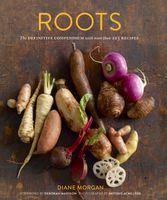🌷 Spring savings – save 25% on ckbk Premium Membership with code SPRING25
History and Lore
By Diane Morgan
Published 2012
Despite the name, horseradish is not a radish at all, though it does belong to the same big family, Brassicaceae, as the radish does—along with lots of other well-known vegetables, such as cabbage, cauliflower, and broccoli. In 1597, the English herbalist John Gerard, in his highly regarded Herball, or Generall Historie of Plantes, described horse radish, probably employing the prefix horse to denote a coarse and vigorous plant. This hardy perennial, originally cultivated as a medicinal herb, is likely native to southeastern Europe and western Asia. Some claim it was grown in Egypt around 1500 B.C., before the exodus of the Hebrew slaves, but little or no proof exists. However, it has been one of the symbolic “bitter herbs” at the Passover seder since the Middle Ages. The ancient Greeks and Romans reportedly cultivated horseradish, consuming both the root and the leaves, the latter as a potherb.
Part of
Advertisement
Advertisement


